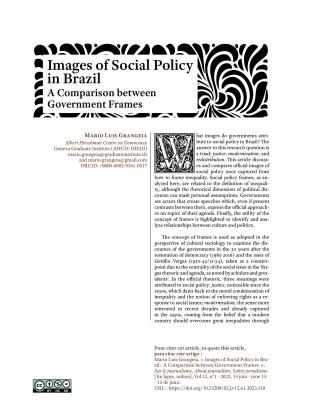The analysis of official representations of social policy in Brazil illustrates the relevance of the concept of framing, as used by cultural sociologists, in comparative studies. The article focuses on the discourse of federal governments subsequent to the restoration of democracy (1985-2016) and the mandates of Getúlio Vargas, once called "father of the poor" in the 1930’s-1950’s. Two challenges in framing research are discussed: the nature of the concept (what is framing) and its operationalization (where is it). Having clarified the theoretical and methodological use of the concept, we move on to recognize and compare framings in 12 inaugural speeches and 39 annual accountability reports of the Executive Branch. Government understandings of four aspects of social policy are more closely analyzed: diagnoses, prognoses, goals, and framing devices. Significance attributed to social policy (such as justice, modernization, and redistribution) undergoes major changes, however continuities also appear, such as the correlation between social development and economic development. Additionally, the paper highlights the advantages of this lens, such as addressing processes in the change of framing, and some of its difficulties, such as minimizing the relational aspect of discourses and reducing framings to more traceable and measurable themes. Intersecting culture and politics enable the identification of the political effects of framings on the evolution of social policy and inequality in Brazil – as demonstrates the representations given of inequality in governmental plans and annual reports. Relevant variables are highlighted in the relations between government priorities (e.g., containing inflation and improving public education) and the agenda of reducing inequality. Some choices of this framing analysis - such as linking diagnoses and prognoses, highlighting secondary framing, and paying attention to framing devices rather than textual details - have added to the effectiveness of the concept. This analytical perspective, still little used by scholars working on these topics, contributes to the research agenda on social policy and inequality.



